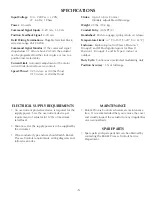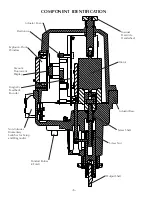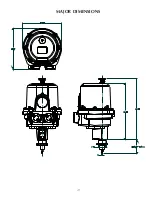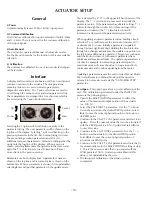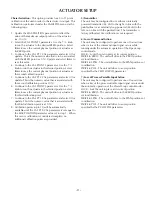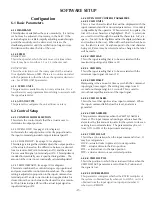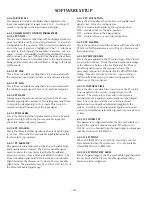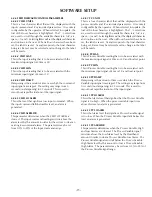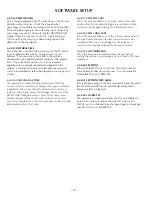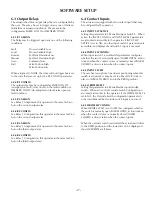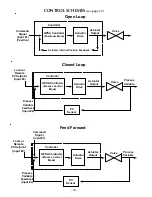
-19-
7 Status
7.1 ALARMS
There are several conditions which will trigger an alarm on
the actuator. An alarm state is denoted by the icon of a bell
being displayed in the lower left hand corner of the display.
All alarms are self clearing. Should the condition that caused
the alarm no longer exist, the bell icon will be erased.
To see the specific alarm(s) in effect, the user looks at this
menu. When this menu is displayed selecting
E
nter will
expand the display to show the current alarms on the lower
line of the display. The upper line of the display will now
read ACTIVE ALARMS. If no alarms are active the lower line
of the display will show NONE. However, if an alarm is
active, the name of the alarm is shown. It is possible that
more than one alarm may be active. Use the
↑
/
↓
knob to
scroll through the list of active alarms. Possible alarms that
may occur are:
Stall
Loss of Remote Set Point Signal
Loss of Feedback Position Signal
Loss of Command Signal
Loss of Process Variable Signal
Process Variable High
Process Variable Low
Set Point Deviation High
Set Point Deviation Low
Command Low
7.2 FAULT HISTORY
This is a circular listing of the last 10 faults that have occurred
in the actuator. The faults messages are preceded with a
number indicating where in the history each fault occurred. 0
indicates the most recent error; a 1 is the error that occurred
before error 0 and so on… The numbers increase as one
looks back into the fault history of the unit. A total of 10
faults are stored. If this capacity is exceeded, the oldest
error is removed from the list and the most recent is added
to it
7.3 AMP TEMP
This is the current temperature of the unit in degrees C
7.4
ACT STATUS
This is a code to show the current state of the actuator.
7.5 ACT STARTS
This is the number of times since the last power up cycle
that the actuator has been moved in either direction. This
value is not stored in permanent memory and is reset to zero
upon each Amplifier power cycle.
7.6 AMP STARTS
This is the number of times that the amplifier has been
powered up. This count is saved in permanent memory.
7.7 SOFTWARE VER
This is the version number of the software that is currently
loaded into the actuator. It is not user adjustable.
6.6.6 ENCODER INIT
Note this procedure invalidates the position configuration
of the actuator.
If performed improperly or incompletely
the changes will allow the actuator to run out of its
expected range which could cause damage to the actuator
and/or to the devices to which it is connected. This
procedure should only be run in the event that the control
board or feedback device has been replaced.
The GPSA is a precision actuator using a feedback device to
determine its position. The feedback devices are individually
calibrated to the actuator in which they are used during
production at our factory. In the unlikely event that the
control board or feedback encoder needs to be replaced,
they will need to be recalibrated as a pair. It is a simple
procedure but it is important to ensure that once performed,
the output position of the actuator is also recalibrated to
ensure safe and proper operation on the unit.
Selecting
E
nter will start the encoder recalibration procedure.
The operator will then be asked if they want to recalibrate
the encoder. If
E
nter is selected, the user will then be asked
“ARE YOU CERTAIN”. Again, selecting
E
nter will proceed
with the calibration. The user is then directed to run the
actuator to its center position. The arrow knob will position
the actuator. The plate covering the output shaft should be
removed by unscrewing the 6 screws which hold it in place.
Adjust the actuator so that the position indicator knob on the
output shaft aligns with the middle two screw holes that held
the cover plate in place. Up until this point (before this
selection of
E
nter),
C
ancel may be selected and no change
will be made to the actuator. Once the unit is positioned
properly selecting
E
nter will calibrate the encoder to the
actuator’s center position. A flashing message is then
displayed to remind the operator that they must recalibrate
the output position of the unit. The encoder is now
calibrated and the cover plate should be replaced.
IMPORTANT
: It is now required to recalibrate the actuators
output position via either the Zero-Span or Characterize
calibration procedures. Failure to recalibrate the actuators
output position could cause damage to the actuator and/or to
the equipment to which it is connected.
6.6.7 INVERT DISP
This parameter allows the display and the Knob functions to
be “inverted” should the actuator be installed in a way that
would result in the display being upside down. Setting this
parameter to YES will rotate the display 180 degrees.
6.6.8 LANG SELECT
This parameter selects the display language used by the
actuator. A selection of English, Spanish, French or German
may be chosen.
SOFTWARE SETUP

